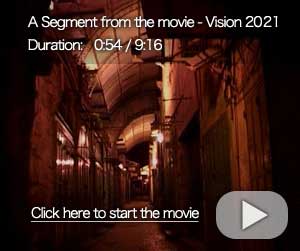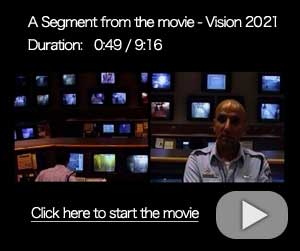“Vision 2021”
Video Installation


“Vision 2021” is a continuing project of a video installation started in 2002
The footage was shot in East Jerusalem.
Installation In Hertzelia Museum:
The installation was designed architecturally in two parts:
The first one is an informative section- it’s a lighted “lobby” leading to the dark projection room, two monitors (like two eyes) placed on eye level screening the control center and the policeman in-charge, introducing and “guarding” the entrance to the another, enclosure- dark section in which the video of the Old City of Jerusalem is screened in full size from the floor up, continuing the perspective of the room and creating an enclosed virtual experience.
In the ceiling of this section I created a sculptural element connected to a specific moment in the movie of the Old City, an inside out view of a manhole in the Old City. The light through the partially opened manhole created the impression of a crescent. A “bone ladder” descended from this manhole into the screening room, thronging its shadow simultaneously on the screened movie. The word ‘bone’ in Hebrew has two meanings. On one hand it means a skeleton bone and on the other hand it means Self. Therefore, this ladder functions as a “self rescue ladder”.
Installation In Betzalel Academy:
The installation was designed architecturally so it creates an entrance “lobby” which was an informative outside section. it was located in an entrances junction and led to the enclosed experience, where the video was screened in full size from the floor up. Creating a virtual experience. In the corridor that leads to the lobby I exposed the whole floor electric wire, the fire equipment behind a plastic glass. At the end of the corridor one could realize that two monitors gazing towards him with information and the policeman guarded the entrance.
Vision 2004, video installation, 2003 – Herzelia Museum:
(Every year the name of the installation changes and receives the date of the relevant following year just like a new model of a car).
…”The question of movement is a fundamental motif in Rothschild’s projects. Her work questions situations both impossible and hypothetical, involving the interrelations between time, space, movement, and observation, in order to explore the connections between mental, personal spaces and political public ones.
The installation Vision 2004 investigates the relationship between restriction and limitlessness through simultaneity and contrast. The Old City of Jerusalem is seen from the perspective of a police control room and from the lens of a camera floating through the narrow and empty Old City alleys at night. In 1998 the Israeli police launched a surveillance project named ”Mabat 2000.” Nearly 300 cameras cover the entire Old City around the clock. The installation contrasts a floating motion through the city with shots from inside the control room and a frontal interview with a police officer. It sets out to explore who the real “master of sight” is. A life-size format of the projection creates a virtual effect, changing the viewer’s orientation within the space and creating an effect of mental architectures traveling in a specific political present.
The journey is towards a vanishing point, while the body itself becomes the link between the interior and the exterior space. This produces a situation of consciousness locked in a static moment – the body. The erotic effect created by these unlimited dynamics is tamed by the introduction of centers of control. This constellation serves as a matrix in which consciousness of the interplay between dynamic and static, freedom and imprisonment, private and public existence, vigilance and trance, reality and virtuality results from unrestricted physicality and the desertion of a totalitarian control apparatus.”
“It began as a personal experience as I was wandering through the streets of East Jerusalem one night when I noticed they were totally empty and there were surveillance cameras everywhere.
I was immediately definite to find out where the control center was and who was there. I wanted to find the “brain”. I located the control room in a Jerusalem police station. The surveillance project is known as “Vision 2000.” It was an Orwellian room filled with television monitors and staffed by dozens of security personnel.
I conceptualized this project on two levels of movement: static and impersonal versus warm and unrestricted. The camera work through the old city, is an attempt to create smooth, floating, free movement; Jump cuts imply the rigid, sterile nature of the control room. It is an exploration of the relationship between free movement and the rigid, unforgiving gaze”.

















